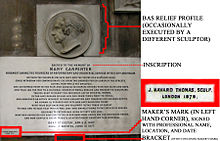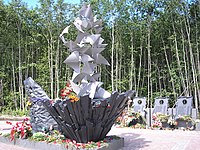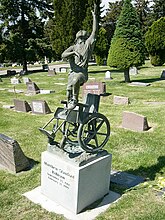Memorial


Amemorialis an object or place which serves as a focus for the memory or the commemoration of something, usually an influential,deceasedperson or a historical,tragic event.Popular forms of memorials include landmark objects such as homes or other sites, orworks of artsuch assculptures,statues,fountainsorparks.Larger memorials may be known asmonuments.
Types[edit]
The most common type of memorial is thegravestoneor thememorial plaque.Also common arewar memorialscommemorating those who have died in wars. Memorials in the form of a cross are calledintending crosses.
Online memorialsare often created on websites and social media to allow digital access as an alternative to physical memorials which may not be feasible or easily accessible.
When somebody has died, the family may request that a memorial gift (usually money) be given to a designated charity, or that a tree be planted in memory of the person.[1]Those temporary or makeshift memorials are also called grassroots memorials.[2]
Sometimes, when a student has died, the memorials are placed in the form of a scholarship, to be awarded to high-achieving students in future years.
Memorials to persons or events of major significance may be designated asnational memorials.
-
Memorial dedicated to the victims of the2010 Polish Air Force Tu-154 crashinSmoleńskat theChurch of St. RochinBiałystok,Poland
-
The Airborne Museum inArnhem,Netherlandscommemorates the liberation of the city during World War II
-
St. Andrew Memorial ChurchinSouth Bound Brook,New Jersey,was built in 1965 to commemorate the victims of theHolodomor
-
Namantar Shahid Smarakcommemorates theNamantar Andolan
-
The grave memorial for a ten year old disabled boy; Matthew Stanford Robison.Salt Lake City CemeteryUtah.
-
Homemade memorial in Brooklyn, NYC featuring a photo cut-out of the deceased giving themiddle-finger
See also[edit]
- Lists of monuments and memorials
- Ghost bike
- Historical marker
- Memorial bench
- Memorialization
- National monument
- Public history
- Roadside memorial
- Tomb of the Unknown Soldier
- War memorial
- Culture of Remembrance
References[edit]
- ^"Commemorative trees".National Trust.1 September 1997. Archived fromthe originalon 10 December 2010.Retrieved4 December2010.
- ^Grassroots Memorials: The Politics of Memorializing Traumatic Death,eds Peter Jan Margry and Cristina Sánchez-Carretero (New York: Berghahn, 2011).














